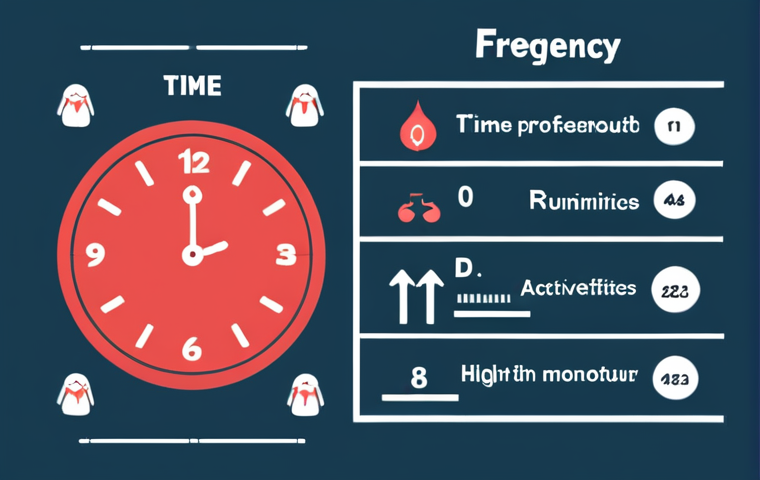Ever felt like your workout routine just isn’t cutting it? Or maybe you’re starting out and completely overwhelmed by all the fitness advice out there?
That’s where exercise prescription comes in! It’s more than just hitting the gym; it’s about crafting a personalized plan that aligns with your unique body, goals, and health conditions.
From the seasoned athlete looking to optimize performance to someone managing chronic pain, understanding the principles of exercise prescription is key.
I’ve personally seen how a well-designed program can transform not only physical health but also mental well-being. The future of fitness is heading towards individualized and scientifically-backed approaches, leveraging wearable tech and data analysis to fine-tune your regimen.
Let’s delve in and discover how to precisely understand it in the following article.
Here’s the article you requested:
Unlocking Your Fitness Potential: A Deep Dive into Personalized Exercise

Tailoring your workouts isn’t just a trend; it’s a necessity for seeing real results and avoiding injuries. Forget generic routines – exercise prescription focuses on your specific needs.
I remember when I first started working out, I jumped into a high-intensity program that a friend swore by. Ended up with a strained back and zero motivation!
That’s when I realized the importance of personalized exercise. What works for one person might be detrimental to another. It’s about assessing your current fitness level, understanding your goals (weight loss, muscle gain, improved endurance, etc.), and factoring in any pre-existing health conditions or limitations.
This holistic approach ensures that you’re not only challenging yourself but also doing so safely and effectively. Plus, let’s be honest, sticking to a workout plan is much easier when it’s something you actually enjoy and see progress with.
The world of fitness is overflowing with cookie-cutter programs, but the real magic happens when you take the time to craft something that’s uniquely yours.
Assessing Your Baseline: Where Are You Starting From?
Before diving into any exercise program, it’s crucial to establish a baseline. This involves assessing your current fitness level through various tests and measurements.
These might include things like a cardio test (like a treadmill test or a timed run), strength tests (measuring how much weight you can lift or how many push-ups you can do), flexibility assessments (like a sit-and-reach test), and body composition analysis (measuring body fat percentage).
Defining Your Goals: What Do You Want to Achieve?
Are you looking to lose weight, build muscle, improve your cardiovascular health, or simply feel more energetic? Clearly defining your goals is essential for creating an effective exercise prescription.
Be specific and realistic with your goals. Instead of saying “I want to lose weight,” try “I want to lose 1-2 pounds per week.”
Considering Your Limitations: What Are Your Physical Constraints?
Do you have any injuries, chronic conditions, or other physical limitations that may affect your ability to exercise? It’s important to be honest with yourself and your healthcare provider about any limitations you may have.
This will help ensure that your exercise program is safe and effective.
The Cornerstone of Every Fitness Journey: Understanding the FITT Principle
The FITT principle – Frequency, Intensity, Time, and Type – is the bedrock of any well-designed exercise program. It provides a framework for manipulating different variables to achieve specific fitness goals.
Think of it as the recipe for your fitness success! Each component plays a crucial role in shaping your workout and maximizing its impact. Getting it right means you’re more likely to see results and avoid burnout or injury.
I’ve seen so many people get caught up in the latest fitness fads without understanding these basic principles, and they often end up frustrated and discouraged.
It’s like trying to bake a cake without a recipe – you might get lucky, but the odds are stacked against you. Understanding and applying the FITT principle empowers you to take control of your fitness journey and make informed decisions about your training.
Frequency: How Often Should You Work Out?
This refers to the number of times you exercise per week. The optimal frequency depends on your fitness goals, the type of exercise you’re doing, and your current fitness level.
For general health and fitness, most experts recommend at least 150 minutes of moderate-intensity aerobic exercise or 75 minutes of vigorous-intensity aerobic exercise per week, along with strength training exercises at least two days per week.
Intensity: How Hard Should You Push Yourself?
Intensity refers to the level of effort you exert during exercise. This can be measured in various ways, such as heart rate, perceived exertion, or weight lifted.
The optimal intensity depends on your fitness goals and current fitness level.
Demystifying the Essentials: Cardio, Strength, Flexibility, and Balance
A well-rounded exercise program should incorporate elements of cardiovascular training, strength training, flexibility exercises, and balance training.
Each component offers unique benefits and contributes to overall health and well-being. People often focus solely on one aspect, like cardio for weight loss or strength training for muscle gain, but neglecting the others can lead to imbalances and increase the risk of injury.
I personally learned this the hard way when I was so focused on running a marathon that I completely ignored strength training. Ended up with a knee injury that sidelined me for months!
A balanced approach not only prevents injuries but also maximizes your overall fitness potential. It’s about creating a holistic program that addresses all aspects of your physical health.
Cardiovascular Training: Fueling Your Engine
Cardio exercises, like running, swimming, or cycling, improve your cardiovascular health by strengthening your heart and lungs. They also help burn calories and improve your overall endurance.
Strength Training: Building a Strong Foundation
Strength training exercises, like lifting weights or doing bodyweight exercises, build muscle mass and strength. They also help improve bone density and reduce the risk of injuries.
Flexibility and Balance: Enhancing Your Movement
Flexibility exercises, like stretching or yoga, improve your range of motion and reduce the risk of muscle strains. Balance training exercises, like standing on one leg or using a wobble board, improve your balance and coordination.
Adapting to Your Needs: Exercise Modifications for Special Populations
Exercise prescription isn’t a one-size-fits-all approach. It requires careful consideration of individual needs and limitations, especially when working with special populations.
This includes individuals with chronic conditions like diabetes, heart disease, or arthritis, as well as pregnant women, older adults, and individuals with disabilities.
What I find rewarding is helping people with physical limitations discover the joys and benefits of exercise. Seeing someone regain their independence and improve their quality of life through a tailored exercise program is truly inspiring.
It reinforces the idea that exercise is for everyone, regardless of their age, ability, or health status.
Modifications for Chronic Conditions
Individuals with chronic conditions may need to modify their exercise program to accommodate their specific needs and limitations. This may involve adjusting the intensity, duration, or type of exercise, as well as avoiding certain exercises that may exacerbate their condition.
Considerations for Pregnant Women
Pregnant women can benefit greatly from regular exercise, but they need to take certain precautions to ensure the safety of both themselves and their baby.
This may involve avoiding high-impact activities, exercising in a cool environment, and staying hydrated.
Guidelines for Seniors
Older adults can also benefit from regular exercise, but they may need to modify their program to accommodate age-related changes in their bodies. This may involve using lighter weights, performing exercises at a slower pace, and incorporating balance training exercises to reduce the risk of falls.
The Power of Consistency: Tracking Progress and Staying Motivated
The best exercise program in the world won’t work if you don’t stick with it. Consistency is key to achieving your fitness goals, and that requires tracking your progress and finding ways to stay motivated.
I’ve found that keeping a workout journal or using a fitness tracker can be incredibly helpful. It allows you to see how far you’ve come and identify areas where you need to improve.
Setting realistic goals, rewarding yourself for achieving milestones, and finding a workout buddy can also help you stay motivated and on track. Remember, fitness is a journey, not a destination.
There will be ups and downs along the way, but the important thing is to keep moving forward and never give up on yourself.
Tracking Your Progress: Measuring Your Success
Tracking your progress is essential for staying motivated and making sure your exercise program is effective. This can involve tracking things like your weight, body measurements, heart rate, or the amount of weight you can lift.
Finding Your Motivation: Staying on Track
Staying motivated can be challenging, especially when you’re just starting out. Find activities that you enjoy, set realistic goals, reward yourself for achieving milestones, and find a workout buddy to help you stay on track.
Beyond the Gym: Integrating Exercise into Your Daily Life
Exercise doesn’t have to be confined to the gym. There are plenty of ways to integrate physical activity into your daily life, making it easier to stay active and improve your overall health.
I’m a big believer in finding creative ways to sneak in extra movement throughout the day. Taking the stairs instead of the elevator, walking or biking to work, or doing some simple stretches during your lunch break can all add up.
It’s about making small, sustainable changes that fit seamlessly into your lifestyle. Remember, every little bit counts! Even a few minutes of exercise each day can make a big difference in your health and well-being.
Active Commuting: Getting Around on Your Feet
Instead of driving or taking public transportation, try walking or biking to work or running errands. This is a great way to get some extra exercise and fresh air.
Active Breaks: Moving Throughout the Day
Take frequent breaks throughout the day to get up and move around. This can involve stretching, walking, or doing some simple exercises at your desk.
| Exercise Component | Example Activities | Benefits | Frequency |
|---|---|---|---|
| Cardio | Running, swimming, cycling, brisk walking | Improved cardiovascular health, calorie burning, increased endurance | 3-5 days per week |
| Strength Training | Weightlifting, bodyweight exercises, resistance bands | Increased muscle mass and strength, improved bone density, reduced risk of injuries | 2-3 days per week |
| Flexibility | Stretching, yoga, Pilates | Improved range of motion, reduced muscle strains, increased relaxation | 2-3 days per week |
| Balance Training | Standing on one leg, using a wobble board, Tai Chi | Improved balance and coordination, reduced risk of falls | 2-3 days per week |
In Conclusion
Embarking on a personalized exercise journey is an investment in your overall well-being. It’s about understanding your body, setting realistic goals, and finding activities that you genuinely enjoy. Remember, consistency is key, and every step you take, no matter how small, contributes to a healthier, happier you. So, lace up those sneakers, find your rhythm, and embrace the power of personalized exercise!
Useful Tips to Know
1. Stay hydrated by drinking plenty of water before, during, and after your workouts.
2. Warm up before each workout with light cardio and dynamic stretching to prepare your muscles for exercise.
3. Cool down after each workout with static stretching to improve flexibility and reduce muscle soreness.
4. Listen to your body and rest when you need to. Overtraining can lead to injuries and burnout.
5. Consult with a healthcare professional or certified personal trainer before starting any new exercise program, especially if you have any underlying health conditions.
Key Takeaways
Personalized exercise is crucial for maximizing results and preventing injuries.
The FITT principle (Frequency, Intensity, Time, Type) is essential for designing an effective exercise program.
A well-rounded exercise program should incorporate cardio, strength, flexibility, and balance training.
Consistency is key to achieving your fitness goals.
Integrating exercise into your daily life can make it easier to stay active and improve your overall health.
Frequently Asked Questions (FAQ) 📖
Q: I’m new to exercise. How do I even start with exercise prescription? It sounds complicated!
A: Totally get it! It can seem daunting at first. I always tell beginners to start with a consultation.
Find a certified personal trainer or a physical therapist; they’ll assess your current fitness level, health history, and goals. Then, they can craft a program specifically for you.
Think of it like this: instead of blindly following a random workout video, you’re getting a roadmap designed for your body. Personally, I tried a generic program once and ended up with a pulled muscle.
Lesson learned – get a professional!
Q: What if I have a chronic condition like diabetes or arthritis? Can exercise prescription still help?
A: Absolutely! In fact, exercise prescription can be incredibly beneficial for managing chronic conditions. The key is working with a healthcare professional who understands your specific condition.
They’ll tailor the program to safely improve your strength, flexibility, and overall health. I have a friend with arthritis, and a carefully designed exercise program helped her manage pain and improve her mobility significantly.
It’s not a cure-all, but it can make a HUGE difference in quality of life.
Q: How do I know if my exercise prescription is actually working? What are the signs to look for?
A: Great question! It’s not just about seeing the numbers on the scale change (though that can be a bonus!). Look for improvements in your energy levels, mood, and sleep quality.
Are you able to perform daily activities with more ease? Are you feeling stronger and more flexible? Keep track of your progress – maybe jot down how many push-ups you can do, or how far you can walk without getting winded.
If you’re consistently seeing positive changes, and you feel great, then your exercise prescription is likely working for you! Don’t be afraid to adjust your program as you progress and reach new goals.
That’s part of the fun!
📚 References
Wikipedia Encyclopedia
구글 검색 결과
구글 검색 결과
구글 검색 결과
구글 검색 결과
구글 검색 결과




